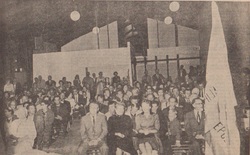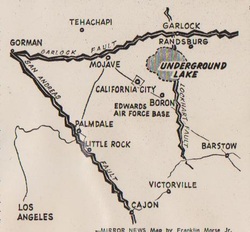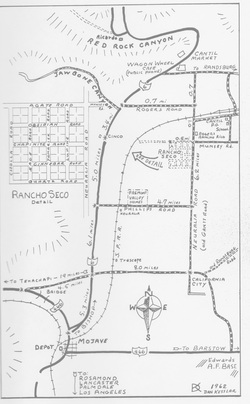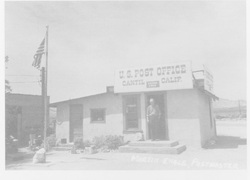M & R Ranch

California City's first town hall, was inside a remodeled warehouse building from the old M & R Ranch. The dedication ceremony took place on November 19, 1960, with Mrs Oscar Rudnick widow of one of the ranch founders, and Joe Mendiburu, son of the other founder Gregorio Mendiburu, in attendance. The building still stands today, and is owned and maintained by the California City Community Club, located in the 8200 block of Dogbane Avenue.
The M & R Ranch was founded by Gregorio Mendiburu and Oscar Rudnick. Their headquarters was centered at the former "Deuce of Diamonds" ranch, in Cantil. In 1947, the M & R Sheep Company brought electricity into the area from Randsburg at great company expense. This made it possible for other area residents to secure the convenience of electricty.
The M & R Ranch was founded by Gregorio Mendiburu and Oscar Rudnick. Their headquarters was centered at the former "Deuce of Diamonds" ranch, in Cantil. In 1947, the M & R Sheep Company brought electricity into the area from Randsburg at great company expense. This made it possible for other area residents to secure the convenience of electricty.
Underground Lake

In 1956 Nat Mendelsohn discovered the vast M & R (Mendiburu & Rudnick) Ranch in the Boron Valley northeast of Mojave. Besides running sheep the ranch grew extensive fields of cotton and alfalfa, irrigated by eleven high-producing water wells. To his surprise, he learned that the water level in the wells never dropped, no matter how hard they were pumped. There seemed to be an inexhaustible supply of water under the Boron Valley.
The lake covers at least 30 square miles and is as much as 3800 feet deep. It is replenished at the rate of 1,000,000 acre-feet annually.
The lake covers at least 30 square miles and is as much as 3800 feet deep. It is replenished at the rate of 1,000,000 acre-feet annually.
Cantil, CA

The first permanent inhabitants who came to the Cantil area, did so for purposes of homesteading, circa 1911. The early homesteaders arrived to find the name "Cantil" on a sign beside the wooden platform next to the railway track. This was on the old Jawbone spur line which ran from Mojave to Owens Valley.
Each day when the train passed through, it would stop just long enough to toss the mail bag onto a hook and throw off pieces of freight. There being no post office facilities, the settlers searched the contents of the bag, selected their own mail and would hang the bag back on the hook, to await the arrival of the next settler.
Cantil is a Spanish word meaning "steep rock", thought to be a refernce to nearby Red Rock Canyon. The railroad stop was originally known as Siding 6 before becoming Cantil on October 20, 1908.
Post Office

A Post Office was established by 1914 with operations within the Cantil Store. A one-room school building was erected near the "General Store". For ten years this school building served as a community center. In 1945, the store closed and was never reopened, though the Post Office portion remained open. In 1948, Martin Engel moved his former assayer's office from the Yellow Aster Mining Company onto his property in Cantil. The Post Office was re-located into this building and Mr Engel became the Postmaster up until his retirement in 1972. The Post Office was then moved to the Jawbone Station on State Route 14.
The original school building had been in constant operation since 1914. In 1938, a new "one teacher" building was constructed. By 1952, the student population had increased so, that a second teacher was added. A few years later, the Cantil District joined the Mojave Unified School District.
By 1946, the Cantil area began to fulfill many predictions made by its first settlers. Agricultural activities were launched on a large scale by the M & R Ranch.
Near the intersection of Pappas and Valley Roads is "Desert Springs", a State Registered Landmark # 476. This spring was on the old indian horsethief trail and later (1834) Joe Walker trail. The famished Manly-Jayhawk Death Valley parties (1849-50) were revived here after coming from Indian Wells through Last Chance Canyon. This was also a station on the Nadeau borax freight road.
The original school building had been in constant operation since 1914. In 1938, a new "one teacher" building was constructed. By 1952, the student population had increased so, that a second teacher was added. A few years later, the Cantil District joined the Mojave Unified School District.
By 1946, the Cantil area began to fulfill many predictions made by its first settlers. Agricultural activities were launched on a large scale by the M & R Ranch.
Near the intersection of Pappas and Valley Roads is "Desert Springs", a State Registered Landmark # 476. This spring was on the old indian horsethief trail and later (1834) Joe Walker trail. The famished Manly-Jayhawk Death Valley parties (1849-50) were revived here after coming from Indian Wells through Last Chance Canyon. This was also a station on the Nadeau borax freight road.
